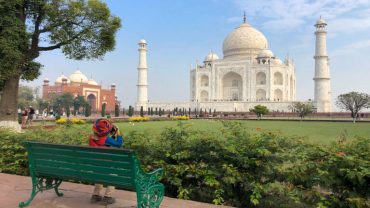Buland Darwaza: A Grand Entrance to the Mughal Empire’s Legacy in Agra
In the historical tapestry of Agra, a city known for its architectural marvels and the indelible mark of the Mughal Empire, the Buland Darwaza stands as a colossal emblem of grandeur. This monumental gateway, often referred to as the “Gate of Magnificence,” serves as both a physical entrance to Fatehpur Sikri and a metaphorical gateway to the enduring legacy of the Mughals. As one stands before the Buland Darwaza, a sense of awe and reverence for the Mughal Empire’s splendor envelops them.
A Triumph of Triumphal Arches
Buland Darwaza, built in 1602 by Emperor Akbar, is a triumphal arch of monumental proportions. Its name, “Buland,” meaning “high” or “great,” aptly conveys its grandeur. This gateway’s scale is awe-inspiring, with a towering height of approximately 54 meters (177 feet) and an expansive width of 35 meters (115 feet). It is celebrated as one of the largest triumphal arches in the world.
As one approaches the Buland Darwaza, its sheer size becomes evident. Constructed primarily from red and buff sandstone, it is embellished with striking white marble, creating a visually striking contrast that highlights the architectural prowess of the Mughal craftsmen. The intricate decorations include Quranic inscriptions, geometric patterns, and floral motifs, showcasing the exceptional craftsmanship that the Mughals were renowned for.
Commemorating a Glorious Victory
Buland Darwaza was constructed to commemorate Emperor Akbar’s triumphant return from his campaign in Gujarat. The gateway symbolizes his victorious conquest and the grandeur of his empire. Emperor Akbar, a visionary ruler, believed not only in military conquest but also in cultural and religious harmony. The inscriptions on the Buland Darwaza emphasize the role of the divine in his victories, reflecting his policy of religious tolerance and respect for all faiths.
Architectural Elegance and Spiritual Significance
The Buland Darwaza is not just a display of architectural grandeur; it also holds spiritual significance. As visitors stand before this colossal gateway, they encounter Quranic inscriptions that extol the greatness of Allah. These inscriptions, composed in elegant calligraphy, add a spiritual dimension to the monument and underscore Akbar’s message of religious tolerance and his recognition of the divine in his accomplishments.
Akbar’s Visionary Legacy
Emperor Akbar, who reigned from 1556 to 1605, was a remarkable and visionary ruler. His rule marked a period of expansion, cultural exchange, and the flourishing of art and architecture. Akbar’s policies promoted harmony among the diverse cultures and religions within his empire, fostering an environment where creativity and architectural excellence thrived.
Buland Darwaza is not merely an architectural marvel; it symbolizes Akbar’s vision and his acknowledgment of the divine in his triumphs. It serves as a representation of his achievements and his enduring impact on the Mughal Empire and the Indian subcontinent.
Fatehpur Sikri: City of Historical Significance
Buland Darwaza is situated within the historic city of Fatehpur Sikri, a UNESCO World Heritage Site. Emperor Akbar founded this city as his capital in the late 16th century. Fatehpur Sikri was a vibrant hub of culture, art, and governance, serving as the Mughal Empire’s seat for over a decade.
The city’s architectural style is a unique fusion of Indian, Persian, and Central Asian influences, making it a remarkable example of Mughal urban planning and architectural achievement. While Fatehpur Sikri boasts several captivating structures, the Buland Darwaza stands as one of its most iconic and imposing landmarks.
A Symbol of Grandeur and Legacy
Buland Darwaza is not merely an architectural wonder; it is a symbol of grandeur, legacy, and the enduring might of the Mughal Empire. As visitors stand before this colossal gateway, they are transported back in time to an era of emperors, conquests, and cultural confluence. The gateway is a reminder of India’s rich history, where rulers like Akbar left not only magnificent structures but also a legacy of tolerance and respect for diverse beliefs.
Visiting the Buland Darwaza
The Buland Darwaza is easily accessible from Agra and is a popular destination for tourists interested in exploring the Mughal heritage of the region. Visitors can marvel at its architectural beauty, explore the inscriptions, and immerse themselves in the historical and spiritual significance of this monumental gateway. It is a must-visit destination for anyone eager to delve into India’s rich history and the legacy of the Mughal Empire.
In conclusion, the Buland Darwaza is a grand entrance to the Mughal Empire’s legacy. It encapsulates the spirit of a great ruler, Emperor Akbar, and stands as a symbol of his accomplishments and his enduring impact on India’s history. It is a living testament to the grandeur and architectural brilliance of the Mughal era, inviting all who pass through its gates to cherish and celebrate this remarkable heritage.
Thank & Regards
Sarfaraz Elahie
The GetExplore Writter
Contact Us
Have questions or need assistance? Feel free to reach out to our dedicated team. We’re here to help you plan your next adventure.




Comment (0)